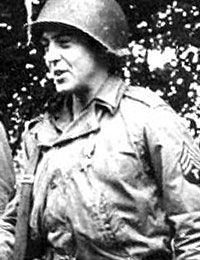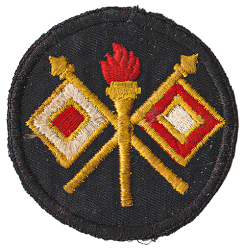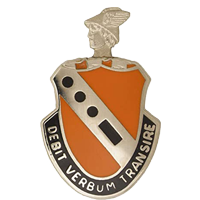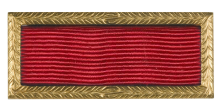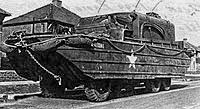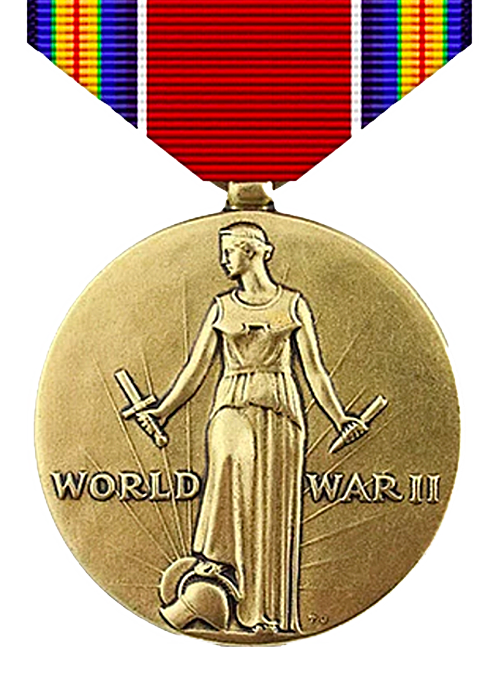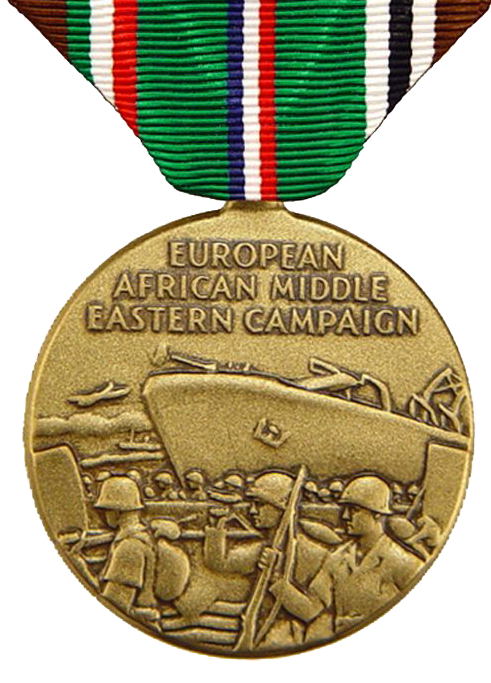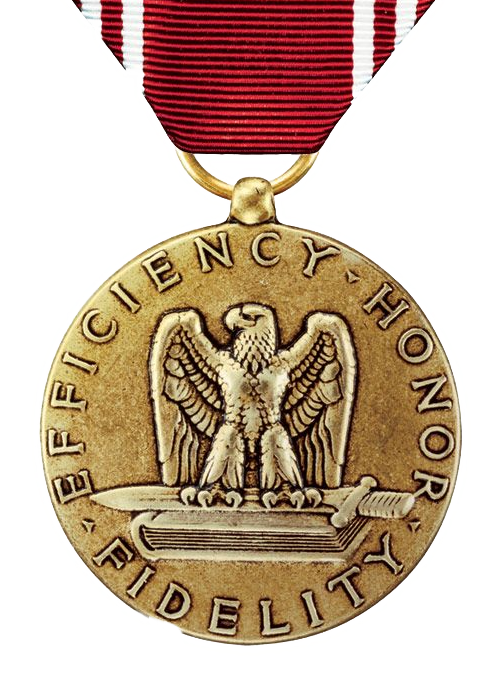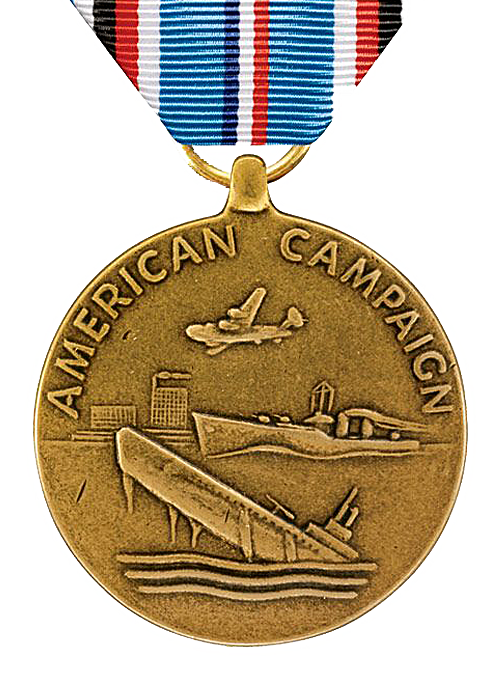I was a radio operator assigned to the 56th Signal Battalion. Our base in England was located at a place called Norton Manor. Norton Manor was an estate of some sort that had been converted to a military installation. It was located a few miles from the city of Taunton, Somersetshire and was the headquarters for Fifth Corps (V Corps), 1st United States Army. Our Battalion was one of the many service troops assigned to V Corps and, in our case, had the responsibility of providing the various communication media for V Corps i.e: radio, wire, etc. About three months, or so, before D-Day a number of the Battalion’s radio operators were ordered to attend a meeting at the V-Corps headquarter complex on the base.
This came as quite a surprise to all of us as this was not our usual stamping grounds. Needless to say, we were curious, puzzled and more than a little apprehensive. We assembled in a private room, with doors closed, and were introduced to Colonel Benjamin B. Talley. He explained to us that he was looking for fifteen men to participate in a mission during the initial phases of the upcoming landings. The mission, he explained, would be dangerous but would be a necessary gear in the machinery and could contribute greatly to the success of the invasion. He told us, as I remember, that we would have a day or so to think it over and then we would reconvene if we were so inclined to volunteer. A few days later those of us, who chose to volunteer, again met with Col. Talley. As I remember, there was no lack of volunteers and of a number to exceed the required fifteen men. Through some process of elimination, fifteen of us were selected to participate in the endeavor. We were also informed that this meeting was the last chance to change our minds about volunteering. Once our training commenced, any man that chose to drop out would be confined incommunicado until the invasion was over. In addition to myself, the following volunteers were selected: S/Sgt Leland Raborn, T/5 Joseph M. Amato, Sgt. John James, T/5 Herbert J. Nelson, T/5 Kenneth M. Richardson, T/5 Willard N. Woodland, PFC Robert E. Bergin, PFC Joseph E. Cunningham, Pvt. James Mildenberger, Pvt. Fred W. Combs, Pvt. Robert (NMI) Ruben, PFC Obert L. Halseth, PFC William (NMI) O’Leary & PFC Robert J. Rasmussen. It was only a few days later we began a series of training sessions. We would be known as the Information Team and we received our assignments. There would be two DUKW’s (A military GMC six wheel drive amphibious vehicle, nicknamed “DUCK”. ) each with a hut-like enclosure,( HO), mounted in the cargo area and housing a SCR 399 long range radio and associated gear, including two 15 foot high antennae.
Six men, in addition to Col. Talley, were assigned to Duck #1 (Command Unit); two radio operators, a driver, an assistant driver a crew chief and the team’s Command Leader, S/Sgt . Raborn. Duck #2 would provide back-up to the command Duck and monitor all radio traffic. Five men were assigned to this Duck, myself included, two radio operators, one driver, one assistant driver and a crew chief. Major Sterling Abernathy in command and an Army observer Col. Ralph W. Zwicker with no command authority. Both Ducks would cross-channel in separate LST’s (Landing Ship Tank), be launched 12 miles at sea and motor in under their own power. In addition to the Ducks there would be two Jeeps, ¼ Ton trucks, each equipped with a smaller shorter ranged radio and associated gear. Two men were assigned to these units, both driver/radio operators. The Jeeps would cross-channel and land from LCT’s [Landing Craft Tank]. We would all land immediately behind the assault troops and provide needed information, regarding the progress of the landing, to the V-Corps Commanding General, Lt.Gen. Leonard T. Gerow. Gen. Gerow would command the landing force from the headquarter ship Ancon, during the initial landings. Up to this point we had no idea where we were going to land or when. On the 26th of May, our training complete, we left Norton Manor, in our respective vehicles, and drove to the coastal marshaling area where troops were amassing to launch the invasion. At the marshaling area we were thoroughly briefed on the landings and, among other things, learned that on the morning of June 5th , later changed to the morning of June 6, due to the inclement weather, we would be landing on the coast of Normandy, France. We would land on Omaha Beach at H plus 60 on Easy Red sector with Regimental Combat Teams of the 1st and 29th Infantry Divisions. Finally, we would start to end this war. The tension and apprehension was rampant among all of us as we learned of our rolls and risks in this massive operation. But there was a feeling of elation too. We had been training for this moment for months, in my case, 17 months.
During the last few months there was a growing feeling that the war was not going to end with all of us, month after month, maneuvering in England. We all felt that we were as trained as we would ever be. Now, at last, it was on. On June 3rd, I believe, we departed the marshaling area and later that day, almost dark, arrived in Weymouth, England and loaded onto our assigned invasion craft LST #54 [Landing Ship Tank]. Our Duck #2, of course, loaded last as we would be first off. We sailed for France early the morning of the 5th but the landings were postponed to the morning of the 6th due to the horrible weather and high seas. So we cruised around and tried very hard not to get seasick. At about 0400 the morning of 6 June1944 we assembled down in the cargo hold of the LST and readied the Duck for launch. The doors opened, the ramp dropped, and we were in the water and on our way. For most of the way in, T/5 Amato the other radio operator, and I were outside with the others watching the naval bombardments, rockets, air bombing as we sloshed on in. The seas were high, approximately six feet and the Duck was much slower than it’s top speed of 5mph. We finally reached the point, about 0600, when we were to begin monitoring the radio traffic and both T/5 Amato and I had to get inside and go to work. The conditions inside of the HO were far from ideal. It was hot. Everything was swinging and sliding due to the high seas and we were sick! I had never been seasick, before or since, but made up for it on that voyage. The worst part was that we could hear all of the gunfire and noises but, of course, had no idea of what was going on outside of the HO or where we were in proximity to the beach. In spite of this we did our job and copied all traffic between Duck #1 and the Ancon. We tried to land three times, I think, and were driven off each time by artillery and small arms fire. I am sure that our pair of 15 foot antennae had a lot to do with that.
In each landing attempt we received damage to the Duck but no casualties. As our job was to provide communications, Col. Talley ordered us to cruise parallel to the beach, observe and report until it became safer to land and set up the command post. We complied with these orders until about 0930 or so. It was then that the damage we had incurred during the landing attempts caught up with us and the Duck was taking on more water than the pumps could handle and the rudder had been severely damaged to the point that the Duck was almost impossible to maneuver. PFC Amato and I were ordered outside and told that he and I, along with crew chief Sgt. James would be put ashore and Major Abernathy and the drivers would try to get the Duck ashore before it sank. After a reasonable amount of time, if they did not make it to shore, we were ordered to find Col. Talley’s CP and join up with them. Accordingly, the drivers (PFC’s Rasmussen and Halseth) somehow maneuvered the heaving Duck up to the stern of a knocked-out LCT and the three of us managed to jump onto it without killing ourselves. The Duck took off along the beach looking for a way through the obstacles to land before sinking. We, on the LCT, ran down the length of it, waded in, made a mad dash for the high water mark, where there was some minimal shelter, and dug in. We laid there, in our holes, for what seemed like an eternity with nothing to really do except to watch and duck. About the time that we were talking of taking off, and finding Col. Talley’s CP, the Duck came rolling up the beach with water pouring out of all of her battle wounds. As dire as the situation was, it was a funny sight.
Major Abernathy ordered us to stay away from the Duck as, with all of the burning vehicles around it, he felt that it would look to the German guns as if it was knocked out. No argument from us. In the meantime he would search out Col. Talley’s CP and obtain further orders and return. About 45 minutes after the Major left, Col. Zwicker appeared and asked me if I shouldn’t be in the Duck monitoring the radio traffic. I relayed on to him the orders that we had received from the Major. He countermanded those orders and ordered Amato and I into the Duck and to get the radio operational. I tried to again explain our orders but he became adamant that we get the Duck operational. Deeming it poor judgement to argue with a Full Colonel, especially under combat conditions, T/5 Amato and I climbed aboard. But before we could fire up the radio, the power units had to be started. We had two gasoline generators on the stern of the Duck. The equipment could be run on one generator but we usually kept both of them operational so that in case we lost one, we would not shut down the radio. I climbed up on the Duck, the deck is about six feet from the ground, worked my way back to the stern and tried to start the generator motors, feeling like the main attraction in a shooting gallery. These engines start with a rewind lanyard, just like a lawn mower motor, and the first one mercifully started with about two pulls. The second one would not start, no matter how many times I pulled.
I started to check to see if we had gasoline and found that most of the gas tank was missing! Some place along the line, that day, something had destroyed it. We’d operate on one. T/5 Amato and I got the receivers and the transmitter fired up and we were in business and quite busy what with the landings in full swing and the resulting heavy radio traffic. After a half hour or so, Sgt. James appeared at the doorway and informed us that we had been ordered, by Col. Zwicker, to move the Duck - reason unknown. We moved about 40 or 50 feet, I would estimate, and were struck by I believe, a mortar round. I think that it landed on the port side of the Duck and exploded the gasoline tanks that lined each side of the HO. The explosion was horrendous and knocked both T/5 Amato and I unconscious. When we regained consciousness we were buried under a spare parts chest that was once fastened to the HO wall behind us. There was huge hole through the wall of the HO just to the right and behind me. Through this I could see that we were on fire. We both heaved the chest off of us, smashed the door open and jumped off the Duck onto the beach. Once outside, we started to search for the rest of the crew. We found PFC Halseth on a stretcher, mortally wounded and to die in a hospital in England on June 8th. We found Sgt. James sitting on a stretcher being treated by medics for terrible burns on his face and back. That also was the end of his war.
We could not find either PFC Rasmussen or Col. Zwicker. Rasmussen was found later by one of the other members of the team with a very bad head wound. He was evacuated to England and later rejoined the Battalion. The Colonel turned up at the CP unharmed. After making sure that our guys were being cared for, T/5 Amato and I took off up the beach and eventually found Col. Talley and the rest of the team. We reported that we were out of action and gave our casualty report. For the rest of the time we remained on the beach, then left to rejoin our Battalion on the 8th, we helped man the radio on Duck #1 and performed any other duties that were required of us. A few weeks after the landings, the entire Information Team were awarded the Silver Star by General Gerow. The Silver Star and a Purple Heart were posthumously awarded to PFC Obert Halseth. In addition, PFC Robert Rasmussen and Sgt. John James were awarded the Purple Heart, as was Pvt. James Mildenberger, the driver of Duck #1, for the wounds that they received, during the assault. T/5 Amato and I finished the war together.
We had originally met on the train from Rochester to Fort Niagara, New York after our enlistment in October of 1942. We returned home together in November of 1945. T/5 Amato was from LeRoy, New York, a small town about 35 miles from my hometown of Rochester, New York. We stayed in close contact until his death in 1974.
ETO Battle Campaigns
- Normandy
- Northern France
- Rhineland
- Ardennes
- Central Europe
Robert R. Chapman
